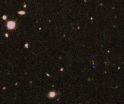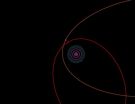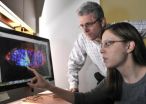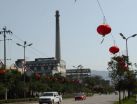(Press-News.org) Washington, D.C.—The Solar System has a new most-distant member, bringing its outer frontier into focus.
New work from Carnegie's Scott Sheppard and Chadwick Trujillo of the Gemini Observatory reports the discovery of a distant dwarf planet, called 2012 VP113, which was found beyond the known edge of the Solar System. This is likely one of thousands of distant objects that are thought to form the so-called inner Oort cloud. What's more, their work indicates the potential presence of an enormous planet, perhaps up to 10 times the size of Earth, not yet seen, but possibly influencing the orbit of 2012 VP113, as well as other inner Oort cloud objects.
Their findings are published March 27 in Nature.
The known Solar System can be divided into three parts: the rocky planets like Earth, which are close to the Sun; the gas giant planets, which are further out; and the frozen objects of the Kuiper belt, which lie just beyond Neptune's orbit. Beyond this, there appears to be an edge to the Solar System where only one object, Sedna, was previously known to exist for its entire orbit. But the newly found 2012 VP113 has an orbit that stays even beyond Sedna, making it the furthest known in the Solar System.
"This is an extraordinary result that redefines our understanding of our Solar System," says Linda Elkins-Tanton, director of Carnegie's Department of Terrestrial Magnetism.
Sedna was discovered beyond the Kuiper Belt edge in 2003, and it was not known if Sedna was unique, as Pluto once was thought to be before the Kuiper Belt was discovered. With the discovery of 2012 VP113 it is now clear Sedna is not unique and is likely the second known member of the hypothesized inner Oort cloud, the likely origin of some comets.
2012 VP113's closest orbit point to the Sun brings it to about 80 times the distance of the Earth from the Sun, a measurement referred to as an astronomical unit or AU. For context, the rocky planets and asteroids exist at distances ranging between .39 and 4.2 AU. Gas giants are found between 5 and 30 AU, and the Kuiper belt (composed of thousands of icy objects, including Pluto) ranges from 30 to 50 AU. In our solar system there is a distinct edge at 50 AU. Only Sedna was known to stay significantly beyond this outer boundary at 76 AU for its entire orbit.
"The search for these distant inner Oort cloud objects beyond Sedna and 2012 VP113 should continue, as they could tell us a lot about how our Solar System formed and evolved," says Sheppard.
Sheppard and Trujillo used the new Dark Energy Camera (DECam) on the NOAO 4 meter telescope in Chile for discovery. DECam has the largest field-of-view of any 4-meter or larger telescope, giving it unprecedented ability to search large areas of sky for faint objects. The Magellan 6.5-meter telescope at Carnegie's Las Campanas Observatory was used to determine the orbit of 2012 VP113 and obtain detailed information about its surface properties.
From the amount of sky searched, Sheppard and Trujillo determine that about 900 objects with orbits like Sedna and 2012 VP113 with sizes larger than 1000 km may exist and that the total population of the inner Oort cloud is likely bigger than that of the Kuiper Belt and main asteroid belt.
"Some of these inner Oort cloud objects could rival the size of Mars or even Earth. This is because many of the inner Oort cloud objects are so distant that even very large ones would be too faint to detect with current technology", says Sheppard.
Both Sedna and 2012 VP113 were found near their closest approach to the Sun, but they both have orbits that go out to hundreds of AU, at which point they would be too faint to discover. In fact, the similarity in the orbits found for Sedna, 2012 VP113 and a few other objects near the edge of the Kuiper Belt suggests that an unknown massive perturbing body may be shepherding these objects into these similar orbital configurations. Sheppard and Trujillo suggest a Super Earth or an even larger object at hundreds of AU could create the shepherding effect seen in the orbits of these objects, which are too distant to be perturbed significantly by any of the known planets.
There are three competing theories for how the inner Oort cloud might have formed. As more objects are found, it will be easier to narrow down which of these theories is most likely accurate. One theory is that a rogue planet could have been tossed out of the giant planet region and could have perturbed objects out of the Kuiper Belt to the inner Oort cloud on its way out. This planet could have been ejected or still be in the distant solar system today. The second theory is that a close stellar encounter could put objects into the inner Oort cloud region. A third theory suggests inner Oort cloud objects are captured extra-solar planets from other stars that were near our Sun in its birth cluster.
The outer Oort cloud is distinguished from the inner Oort cloud because in the outer Oort cloud, starting around 1500 AU, the gravity from other nearby stars perturbs the orbits of the objects, causing objects in the outer Oort cloud to have orbits that change drastically over time. Many of the comets we see were objects that were perturbed out of the outer Oort cloud. Inner Oort cloud objects are not highly affected by the gravity of other stars and thus have more stable and more primordial orbits.
INFORMATION:
Acquisition of data used in this study was supported by NASA. Observations were partly obtained at Cerro Tololo Inter-American Observatory, National Optical Astronomy Observatory, operated by the Foundation of Universities for Research in Astronomy, under contract with the National Science Foundation. This paper also includes data gathered with the 6.5-meter Magellan Telescopes located at Las Campanas Observatory, Chile.
The Carnegie Institution for Science is a private, nonprofit organization headquartered in Washington, D.C., with six research departments throughout the U.S. Since its founding in 1902, the Carnegie Institution has been a pioneering force in basic scientific research. Carnegie scientists are leaders in plant biology, developmental biology, astronomy, materials science, global ecology, and Earth and planetary science.
Solar System's edge redefined
2014-03-26
ELSE PRESS RELEASES FROM THIS DATE:
Penn Dental Medicine-NIH team reverses bone loss in immune disorder
2014-03-26
Patients with leukocyte adhesion deficiency, or LAD, suffer from frequent bacterial infections, including the severe gum disease known as periodontitis. These patients often lose their teeth early in life.
New research by University of Pennsylvania School of Dental Medicine researchers, teaming with investigators from the National Institutes of Health, has demonstrated a method of reversing this bone loss and inflammation.
The work was led by Penn Dental Medicine's George Hajishengallis, professor in the Department of Microbiology, in collaboration with Niki Moutsopoulos ...
Researchers present comprehensive 'roadmap' of blood cells
2014-03-26
(WASHINGTON, March 26, 2014) – Research published online today in Blood, the Journal of the American Society of Hematology, presents an unprecedented look at five unique blood cells in the human body, pinpointing the location of key genetic regulators in these cells and providing a new tool that may help scientists to identify how blood cells form and shed light on the etiology of blood diseases.
Work published today in Blood* is a subset of a much larger catalog of genetic information about nearly 1,000 human cells and tissues unveiled today from the international research ...
3-D MRI scans may offer better way to predict survival after chemo for liver tumors
2014-03-26
In a series of studies involving 140 American men and women with liver tumors, researchers at Johns Hopkins have used specialized 3-D MRI scans to precisely measure living and dying tumor tissue to quickly show whether highly toxic chemotherapy – delivered directly through a tumor's blood supply – is working.
The investigators say their findings, to be presented March 22-27 in San Diego at the annual meeting of the Society of Interventional Radiology, are the first "proof of principle" that this technology can show tumors in three dimensions and accurately measure tumor ...
Lawrence Livermore scientists discover bacterial resistance to improve biofuel production
2014-03-26
Resistance is not futile when it comes to a new method to more efficiently convert biomass to biofuels.
New research by scientists from Lawrence Livermore National Laboratory in conjunction with the Joint BioEnergy Institute (JBEI) suggests that a type of bacterial resistance may provide more efficient production of biofuels.
The team identified the genetic origin of bacterial resistance to an ionic liquid (a salt in the liquid state), which they successfully introduced into a strain of E. coli bacteria for the production of advanced biofuels. The ionic liquid resistance ...
Significant progress toward creating 'benchtop human' reported
2014-03-26
Significant progress toward creating "homo minutus" - a benchtop human -was reported at the Society of Toxicology meeting on Mar. 26 in Phoenix.
The advance - successful development and analysis of a liver human organ construct that responds to exposure to a toxic chemical much like a real liver- was described in a presentation by John Wikswo, the Gordon A. Cain University Professor and Director of the Vanderbilt Institute for Integrative Biosystems Research and Education (VIIBRE) at Vanderbilt University.
The achievement is the first result from a five-year, $19 million ...
UT Southwestern cancer biologists link tumor suppressor gene to stem cells
2014-03-26
DALLAS – March 26, 2014 – Just as archeologists try to decipher ancient tablets to discern their meaning, UT Southwestern Medical Center cancer biologists are working to decode the purpose of an ancient gene considered one of the most important in cancer research.
The p53 gene appears to be involved in signaling other cells instrumental in stopping tumor development. But the p53 gene predates cancer, so scientists are uncertain what its original function is.
In trying to unravel the mystery, Dr. John Abrams, Professor of Cell Biology at UT Southwestern, and his team ...
Biological testing tool, ScanDrop, tests in fraction of time and cost of industry standard
2014-03-26
Northeastern University professor of pharmaceutical sciences, Tania Konry, has developed a single instrument that can conduct a wide range of biological scans in a fraction of the time and cost of industry standard equipment. That's because it uses considerably less material and ultra-sensitive detection methods to do the same thing.
Currently, researchers face enormous time constraints and financial hurdles from having to run these analyses on a regular basis. Hundreds of dollars and 24 hours are what's required to scan biological materials for important biomarkers that ...
Natural history must reclaim its place
2014-03-26
Support in developed countries for natural history—the study of the fundamental nature of organisms and how and where they live and interact with their environment—appears to be in steep decline. Yet natural history provides essential knowledge for fields as varied as human health, food security, conservation, land management, and recreation. In the April issue of BioScience, a group of scientists from institutions across North America details examples supporting their conviction that a revitalization of the practice of natural history will provide important benefits for ...
Coal plant closure in China led to improvements in children's health
2014-03-26
Decreased exposure to air pollution in utero is linked with improved childhood developmental scores and higher levels of brain-derived neurotrophic factor (BDNF), a key protein for brain development, according to a study looking at the closure of a coal-burning power plant in China led by researchers at the Columbia Center for Children's Environmental Health at the Mailman School of Public Health.
The study is the first to assess BDNF and cognitive development with respect to prenatal exposure to polycyclic aromatic hydrocarbons (PAH), a component of air pollution commonly ...
Resistance is not futile
2014-03-26
Researchers with the U.S. Department of Energy (DOE)'s Joint BioEnergy Institute (JBEI), a multi-institutional partnership led by Berkeley Lab, have identified the genetic origins of a microbial resistance to ionic liquids and successfully introduced this resistance into a strain of E. coli bacteria for the production of advanced biofuels. The ionic liquid resistance is based on a pair of genes discovered in a bacterium native to a tropical rainforest in Puerto Rico.
"We identified two genes in Enterobacter lignolyticus, a soil bacterium that is tolerant to imidazolium-based ...






